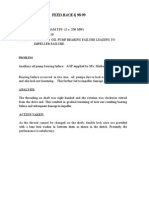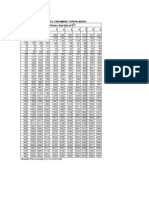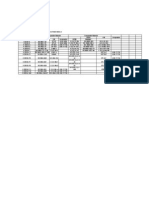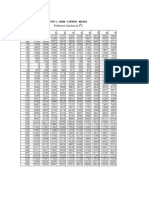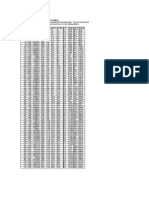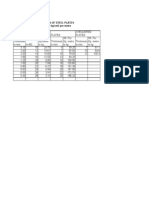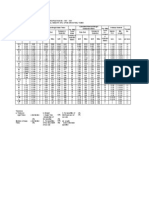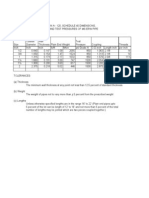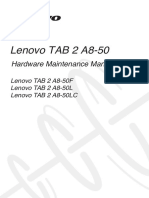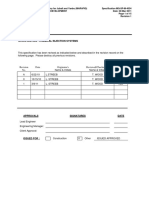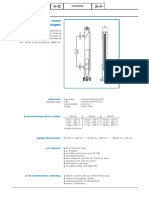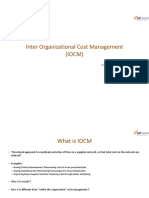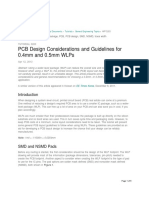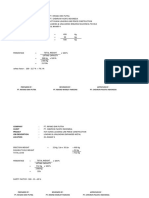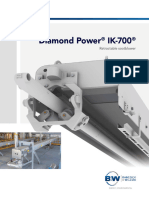SUBJECT : LOW VACUUM IN CONDENSER PROJECT : NORTH CHENNAI/ UNIT-2
PROBLEM : Vacuum gradually worsened at above site, from load to 0.763 Ksc (150 MW) over 30 days 19.06.03. All efforts, including water tightness tube cleaning was ineffective. A summary submitted for study is as tabulated below:
Time Date Load MW Vacuum ksc 1300 1100 1400 1100 0900 0400 1800 1000 1000 1600 17.05.03 22.05.03 27.05.03 02.06.03 07.06.03 12.06.03 19.06.03 22.06.03 27.06.03 27.06.03 210 210 210 200 100 150 150 194 183 155 -0.892 -0.863 -0.800 -0.799 -0.791 -0.78 -0.763 -0.759 -0.763 -0.762 49 54 58 60 60 60 59 63 62 64.8 Hot Well CW Inlet temp (L)/(R) 32 32 34 34 35 35 35 35 36 36 37 37 37 37 35 35 37 37 38 38
0.892 Ksc at full from 17.05.03 to test and condenser of relevant data
CW Outlet temp (L)/(R) 41 40 44 43 45 45 45 44 42 42 43 43 45 44 46 45 47 46 47 46
CW F Bay level (M) 8.4 8.0 8.0 7.5 6.6 6.2 6.5 6.2 6.7 6.7
Remarks
ONE vac. pump in service (Unit 2 only)
TWO vac pumps
Air exhausted from vacuum pumps was exceeding 150 Kg/hr. (Second vacuum pump was installed for unit 1. The air piping was extended to unit-2 from unit-1.)
�ANALYSIS It was decided to check with Helium leak detector. Helium leak detection instrument was used, From 22.07.03 to 24.07.03, to check the following: ? LP Cylinder : Bursting diaphragms, glands of LP seals,
parting plane, Neck weld, LP BP downstream piping. ? ? ? ? Extraction piping: LPH 1 and LPH 2 piping and shell.
Hot well stand pipes & CEP suction and impulse lines Vacuum pump and main ejector Flash tanks and drain cooler
Readings were obtained at LP parting plane (corner), ejector air inlet valve bonnet, ejector drain isolation flange, condenser manhole and two bursting diaphragms. However, ingress was not high. Condenser vacuum & CW inlet and outlet sea water systems were thermally mapped (Fig. 1 shows condenser, Fig.2 shows vacuum pumps) using a laser non-contact thermometer. From this, we could see that mixing of inlet and outlet seawater was taking place -- poor condenser performance due to reduced flow through CW tubes. (Observe how temp. of flow reversal side is higher than outlet). Also observe that temp. of air to vacuum
�pump is getting sub-cooled only in one half. (In Ennore TPS unit 3, similar behavior was observed. corrosion of parting plate of Inspection had revealed heavy inlet/outlet water box. After
correction, in Ennore vacuum went to full value and exhaust temp came down to 45 Deg C at low loads.) CONCLUSION TNEB was advised to make temporary sealing with suitable agent, (M-Seal) etc at identified air ingress points till unit could be shut down. To find a long-term solution they were advised: 1. To service the components showing air ingress and make airtight. 2. Reduce the seal water temp of vacuum pump. 3. Inspect and confirm seawater CW mixing at parting plate of inlet/outlet water box. Make necessary corrections to stop
this in unit 2 and other units of North Chennai. 4. Monitor the thermal and flow behavior (DT, TTD and CW waterbox temperatures; DP and flow across each waterbox)
of all condensers and water boxes of the running units. 5. Make provision for sacrificial anode in CW system to prevent corrosion due to seawater.
�Note: To understand condenser performance DT, TTD, DP and flow must be watched: DT = CW outlet temp CW inlet temp (difference in
temperature between CW inlet and outlet should be about 8-10 deg C at full load of 210 MW. More means less CW flow, less could mean mixing: confirm this by seeing TTD values also.) TTD = Hot well temp - CW outlet temp
(TTD values of 5-6 deg C are normal. Values above 10 indicate worsening condenser performance. 20 or more means very poor
heat exchange possibly due to fouling of condenser tubes or mixing of inlet and outlet CW.)
DP and FLOW: Higher motor currents in axial flow CW pumps could mean restrictions in discharge flow due to choking in debris filter, and higher DP across CW tubes may mean choking in the tubes.




























































